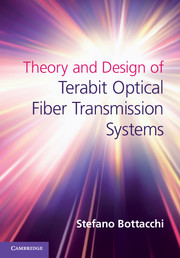Book contents
- Frontmatter
- Dedication
- Contents
- Preface
- Acknowledgments
- Part I Signals, spectra and optical modulations
- 1 Baseband signals and power spectra
- 2 Analytic signals and spectral efficiency
- 3 Optical signals, high-order modulations and spectra
- Part II Principles of light polarization and optical amplification
- Part III Interferometric optical modulators
- Part IV
- Appendix A Electromagnetic energy and power flow
- Appendix B Optical power and photon flux
- Index
- References
2 - Analytic signals and spectral efficiency
Hilbert transforms and new concepts for higher spectral efficiency
from Part I - Signals, spectra and optical modulations
Published online by Cambridge University Press: 05 September 2014
- Frontmatter
- Dedication
- Contents
- Preface
- Acknowledgments
- Part I Signals, spectra and optical modulations
- 1 Baseband signals and power spectra
- 2 Analytic signals and spectral efficiency
- 3 Optical signals, high-order modulations and spectra
- Part II Principles of light polarization and optical amplification
- Part III Interferometric optical modulators
- Part IV
- Appendix A Electromagnetic energy and power flow
- Appendix B Optical power and photon flux
- Index
- References
Summary
Introduction
It is well known that increasing information capacity requires an increase in optical bandwidth as well, effectively limiting the spacing between adjacent channels in a dense wavelength division multiplexing (DWDM) transmission system. Several factors impair system performance when the signal bandwidth occupancy becomes comparable with or exceeds the wavelength grid. Optical filters can sharply cut channel bandwidth in order to avoid linear and non-linear crosstalk with adjacent channels, but if the spectral cutout is not negligible, the signal will suffer from intersymbol interference (ISI) degradation. It is apparent that when the transmission bit rate reaches hundreds of gigabits per second, spectral efficiency techniques, and more specifically high-order optical modulation formats, become indispensable for at least two reasons:
A narrower optical signal bandwidth reduces linear signal impairments arising from chromatic dispersion (CD) and polarization mode dispersion (PMD) of the optical fiber and from band-limited effects of optoelectronic circuits.
A narrower optical bandwidth allows a tighter optical channel grid in DWDM systems, increasing the overall link capacity.
In the current “coherent era” of optical fiber communication, the first point does not create real impairments, as linear dispersion can be completely compensated using appropriate algorithms at the digital signal processing (DSP) stage following the coherent photoreceiver. However, increasing information capacity demand requires continuously denser optical frequency multiplexing, which sets tighter limits on single-channel spectral occupancy. Accordingly, spectral efficiency is becoming one of the most focused items among research and state-of-the-art industrial communication laboratories.
- Type
- Chapter
- Information
- Publisher: Cambridge University PressPrint publication year: 2014



